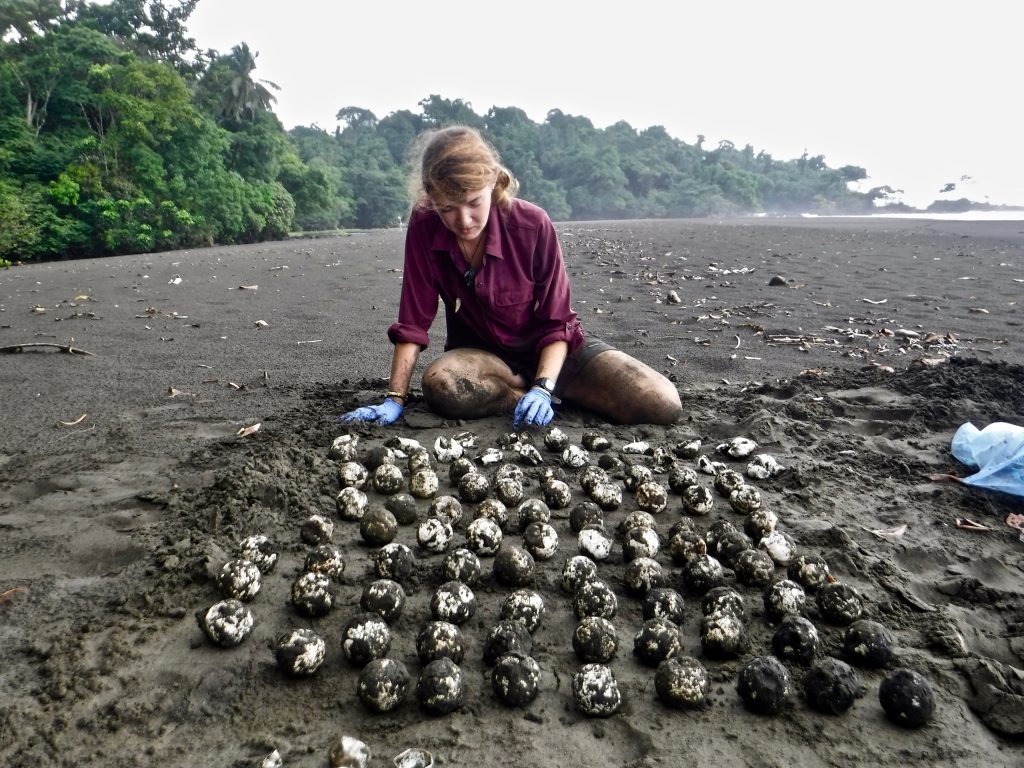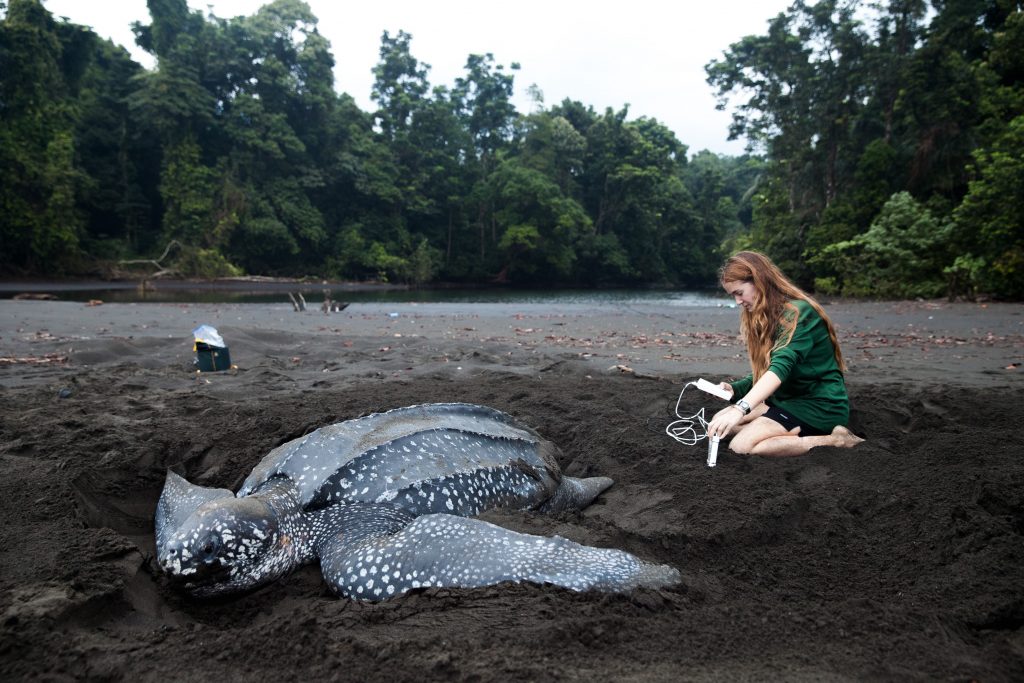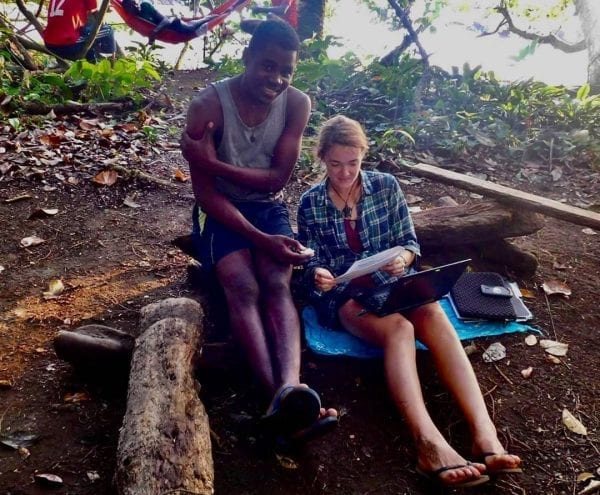January 9, 2015 is a day that will always be embedded in my memory.
I awoke to the words, “Baula baula baula!” getting increasingly louder outside my window at the Ostional National Wildlife Refuge Field Station in Costa Rica. A female adult leatherback sea turtle, una baula, emerged from the ocean and began laying her eggs on the beach half a mile from the station. Not wanting to miss a single second, I sprinted down the beach, unable to contain my anticipation of this long-awaited encounter.
This torpedo-shaped, Volkswagen-sized, white spotted mother was exhaling heavy, prehistoric-sounding breaths as she was determined to haul her body onto the beach. I was immediately struck by the unwieldy and burdened movements of this 1,000-2,000 pound ocean dweller with flippers as she made her way on land. My eyes wet with awe as I witnessed my first massive reptile birthing, knowing how much of a miracle it is each time a nesting female returns to the place of her birth to lay eggs.

After all, only 40-60% of leatherback nests hatch worldwide, and approximately one in 1,000 hatchlings survive the gauntlet of threats awaiting them in their adolescent years.
A declining population threatened by an extinction crisis
Historically, I would have had multiple encounters with nesting females during my months spent patrolling the beach in Ostional. However, due to the devastation of the critically endangered Eastern Pacific (EP) leatherback sea turtle subpopulation, that night was my only encounter.
EP leatherbacks are among the one million animal and plant species currently threatened with extinction. Here are a few disturbing facts about the population of leatherbacks:
- Out of the seven subpopulations of leatherback sea turtles, four are critically endangered and one is endangered, while two are currently data deficient.
- Global threats to leatherbacks include climate change, pollution, habitat loss, poaching, and fishery bycatches.
- Fisheries in the Southeast Pacific are thought to bycatch, or accidentally capture, more than 46,000 turtles of all species per year.
- Leatherback sea turtles can hold their breath for approximately 85 minutes. But, the set times of nets in certain fisheries can be as long as 24 hours, leaving them with no chance of survival.
- In the 1980s and 1990s, there were as many as 35,000 leatherbacks occupying the East Pacific Ocean subpopulation. Today, estimates report less than 1,000 individuals remain — a decline of 98%.
The latest estimates indicate that we have 10-15 years until the East Pacific leatherback sea turtle, arguably the most endangered sea turtle population in the world, is functionally extinct.
Finding inspiration in the need to act urgently
It was predicted that the 2014/15 nesting season in Ostional could potentially be the last. As I watched the leatherback lay her eggs, I realized I was witnessing the extinction trajectory of an ancient reptilian population. That night, I didn’t feel as though I adopted a mission, but rather a mission adopted me. I knew I had to do something.

In April 2019, I started an NGO called The Leatherback Project (TLP) for the global protection of leatherback sea turtles through community empowerment, research and advocacy. Initiatives of the organization include a global citizen science and artificial intelligence photo identification program for the species, a sea turtle monitoring and conservation program in Panama, and a fisheries bycatch reduction program in Ecuador.
The Leatherback Project is also developing a multi-expedition, international investigation of in-water leatherback behavior and habitat use, as well as an international campaign for Rights for Nature. Since sea turtles are flagship species, studying them and their threats to survival can open the doors to larger conversations around the greatest threats facing oceans today.
Saving a species with durable, reliable tech
 Without reliable technology that can withstand humid and harsh conditions, much of our work is impossible! For the past 5 years as I have been working in remote areas of Africa and Latina America, Lenovo ThinkPads have been my field computer of choice. My Lenovo ThinkPad has helped me to create content efficiently, remain connected to my partners and collaborators, conduct complicated data and videos analyses, input and protect my data in the field, and also deploy technology like satellite tags, weather stations and temperature data loggers at remote field sites. My ThinkPad has survived years of sandy, salty and humid fieldwork in tents, backpacks and boats, relying on solar panels and generators in the jungle to power my electronics.
Without reliable technology that can withstand humid and harsh conditions, much of our work is impossible! For the past 5 years as I have been working in remote areas of Africa and Latina America, Lenovo ThinkPads have been my field computer of choice. My Lenovo ThinkPad has helped me to create content efficiently, remain connected to my partners and collaborators, conduct complicated data and videos analyses, input and protect my data in the field, and also deploy technology like satellite tags, weather stations and temperature data loggers at remote field sites. My ThinkPad has survived years of sandy, salty and humid fieldwork in tents, backpacks and boats, relying on solar panels and generators in the jungle to power my electronics.
Earlier this month, I gave a Zoom lecture on my ThinkPad X1 Yoga to over 200 students at an Ecuadorian university about The Leatherback Project’s upcoming pilot project to test bycatch reduction technology in artisanal fisheries. As I look to pursue a doctorate degree in conservation science, I am thankful to have a reliable computer that will run many of the biological, statistical, and spatial data analysis programs that only run on Windows operating systems.
How you can do your part
Since we live on the only known inhabitable blue planet, we must work together across borders, generations and fields to find creative solutions to ocean conservation problems, while we still have the chance. We must be inconvenienced to affect positive change and emboldened by the severity of the present environmental crisis.
You can do your part to save the leatherback sea turtle population by:
- Refusing single-use plastics
- Leading a beach cleanup in your area
- Knowing the source fishery and practices of your seafood
- Putting pressure on your elected officials to combat the climate crisis
- Donating to ocean conservation nonprofit organizations
- Creatively using your skills to find new, innovative pathways for change
By working with local communities, government stakeholders and scientists, The Leatherback Project can work toward sustainable solutions for ocean ecosystems and endangered marine species. Learn more at www.leatherbackproject.org.
Follow us on Instagram (@callieveelenturf & @leatherbackproject) and Facebook to be part of my #LenovoInnovators journey and support The Leatherback Project’s mission.
